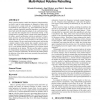Free Online Productivity Tools
i2Speak
i2Symbol
i2OCR
iTex2Img
iWeb2Print
iWeb2Shot
i2Type
iPdf2Split
iPdf2Merge
i2Bopomofo
i2Arabic
i2Style
i2Image
i2PDF
iLatex2Rtf
Sci2ools
ATAL
2008
Springer
2008
Springer
A realistic model of frequency-based multi-robot polyline patrolling
There is growing interest in multi-robot frequency-based patrolling, in which a team of robots optimizes its frequency of point visits, for every point in a target work area. In particular, recent work on patrolling of open polygons (e.g., open-ended fences) has proposed a general cooperative patrolling algorithm, in which robots move back and forth along the polygon, in an synchronized manner, such that their assigned areas of movement overlap. If the overlap factor is carefully chosen--based on the motion models of the robots--specific performance criteria are optimized. Unfortunately, previous work has presented analysis of motion models in which there are no errors in the movement of the robots, and no velocity changes. We go a step beyond existing work, and develop a realistic model of robot motion, that considers velocity uncertainties. We mathematically analyze the model and show how to use it to find optimal patrolling parameters, given known bounds of uncertainty on the motio...
| Added | 12 Oct 2010 |
| Updated | 12 Oct 2010 |
| Type | Conference |
| Year | 2008 |
| Where | ATAL |
| Authors | Yehuda Elmaliach, Asaf Shiloni, Gal A. Kaminka |
Comments (0)

